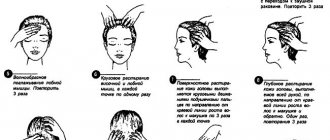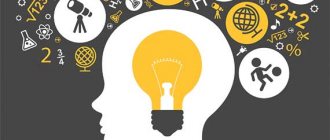Classification of types of memory
Human memory is not fully understood. But now we can say with confidence how its mechanism works:
- Memorization;
- Preservation;
- Reproduction upon recognition;
- Forgetting.
There are two types of memorizing information: voluntary and involuntary. Voluntary memorization is special. This includes cramming poetry, historical dates, and mathematical formulas. In this case, motivation plays a big role. Involuntary memory is quite unpredictable. The child remembers what he saw, heard, touched. Some information ends up in the long-term memory section, while other information is destroyed because it is not needed and the child does not use it. When memorizing, the material is determined by a special structure of the brain - engrams.
There are two types of information storage: dynamic and static. Dynamic storage refers to short-term memory, static storage refers to long-term memory. The latter type is important for a child’s learning. Because he needs to remember important material in class, then return to it in exams, and supplement it when doing homework.
Forgetting unnecessary information is just as important as remembering important information. Forgetting is a procedure for destroying neural connections. The baby’s psyche needs it to avoid overload.
As mental processes become tense, memory is divided into: emotional, motor, figurative and verbal-logical. The first type of memory that a child begins to develop is motor memory. With its help, the baby learns to control his body. Next comes emotional memory. Thanks to her, the baby begins to recognize his parents by face and voice. The baby will not smile at strangers. Figurative memory appears even later. This includes memorizing taste, touch, and images. In addition, associations are formed, with the help of which the memorization process is easier. Verbal-logical memory is the last to develop. She helps the child formulate his thoughts and turn them into words.
Children's memory has its own characteristics. For example, girls develop visual and long-term memory faster and better. And for boys - motor skills. In addition, boys remember numbers better.
Different types of information perception - choose yours.
Why is everyone given the same information in class, but everyone understands and perceives it differently and remembers it at different speeds?
The answer is simple. All people are very different. Everyone has their own perceptions.
Unfortunately, the school does not pay attention to this. Everyone must do what is required by the program. Information is given exactly this way and not otherwise. This is how our system works.
If you notice that a schoolchild has difficulty memorizing information, you should pay attention to the development of memory in younger schoolchildren. The first thing you need is to determine the child’s leading memory. There are three channels of perception:
The first thing you need is to determine the child’s leading memory. There are three channels of perception:
- Auditory or sound.
An auditory person is a person who perceives the vast majority of information through sounds. They most often turn to describing the world around them through sounds. Their dominant sense is hearing, so they tend to have strong communication skills. - Visual, or visual. Visual learners perceive information best in the form of images. He seems to draw certain pictures in his head of what you are trying to convey to him.
Kinetic, it's sensations. For these people, sensitive experience and emotional reinforcement are primarily important. They remember sensations, movements, smells well and are more oriented towards feelings.
There are no “pure” types of memorization. But there are leaders.
Here you need to do this:
Find out the leading type of memorization, teach the child to use it
Additionally develop other channels of information perception.
Auditory child
diligent, attentive, loves to talk and listen. Communication plays a huge role for them. They are characterized by saying their actions out loud.
Visual children
They better remember information that consists of pictures, graphs, diagrams, and highlighted fragments. They have well-developed finger motor skills, but they have difficulty perceiving verbal instructions and therefore often repeat tasks.
The child is kinesthetic
- a real practitioner. He strives to explore the world around him from all sides, feeling and even tasting. At school, a kinesthetic student likes to touch educational materials, assemble or disassemble manuals. They don't really like to read. It's easier for them to write more interestingly. That is why such children are often taught to read through writing.
Age characteristics
At each stage of memory development, preschoolers experience dramatic changes in their ability to memorize and reproduce information. Conventionally, in preschool age, 4 such stages are defined:
- Children under one year of age: motor memory develops, which manifests itself in the first conditioned reflexes. In the first year of life, the child remembers movements and repeats them. Memorization is more effective if learning is accompanied by vivid, emotional action.
- Age from 1 to 2 years: during this period, the baby’s central nervous system actively develops, as a result of which the volume of memorized information and its strength increases. The child recognizes close and dear people, he begins to walk, and his figurative memory develops. The first conscious memories are tied to this age period.
- Age 2-4 years: mechanical memory is actively developing, but after two years the child begins to build a logical chain, remembers words, and develops basic motor skills.
- Age 4-6 years: involuntary memorization predominates. Typically, a child at this age remembers information that turned out to be interesting, exciting, and exciting. This happens regardless of whether the preschooler wants to remember this information.
Description of developmental techniques
There are many means of developing memory in children. The most popular methods are those developed by Glenn Doman and Montessori. The first technique was originally developed as a way to correct children's memory, which has deviations in the field of memorizing information. Then it was adapted for all babies.
A complete rejection of the roles of teacher and student is recommended. A special feature of the technology is that the child can independently choose what he will do. The parent just watches.
There are many interesting and effective developmental techniques. Let's look at some of them.
Puzzles help develop motor skills, perseverance, attention and memory in children of any age. The collected image must be appropriate for the age period
Regular assembly of disparate pieces into a single panel helps to achieve good results in the process of developing attention and memory.
Kids love to look at mixed up pictures. Invite your child to identify the discrepancy between the character and the action depicted. Then let him tell you how the mistakes can be corrected. The kid should notice that instead of the bear cub, Baba Yaga should be placed in the flying mortar, Little Red Riding Hood should change her headdress, and the arrow should be given to Ivan Tsarevich.
Auditory memory can be improved with audio recordings. Include interesting stories and fairy tales several times a week. It is best to have joint auditions. Children's songs and short poems are good for kids. Encourage your child to retell the texts as correctly as possible. The audio recording can be replaced by reading aloud.
Memory formation from 3 to 6 years
Parents need to know how to develop memory in children. During this period of time there is a productive development of attention. The baby effectively and easily learns important material for him, small poems. He tries to set the task himself and achieves it. This is a great age to improve tactile memory and start learning foreign languages. So how can you improve memory performance in a 6-year-old child?
Offer games that develop memory. For example, put various objects on the countertop, tell your son or daughter that he must remember the order and quantity of them, and then rearrange them and remove something completely. At this time, the child closes his eyes, and after your movements he opens them and tries to guess what has changed. Start learning words of a foreign language by matching them with various images and words of your native language.
Development of motor memory
To develop motor memory, you can play “puppet”. The child stands calmly, and the adult controls his arms and legs, forcing him to go right, left, forward. Then the child is asked to repeat the movements from memory.
You can also use the game “Do as I do.” The teacher makes the movements, the child repeats after him.
Developmental activities for preschool children
Memory formation from 10 to 14 years
A 10-year-old child begins the period of highest development of logic and memory. It is worth focusing on tasks that are aimed at further improving attention and intellectual abilities. A 12-year-old child should read a lot of books, play with classmates, and draw. But the time spent on a laptop and phone should be reduced.
Sports activities help improve and develop memory. If a child exercises physically, the body absorbs oxygen faster, which causes the brain to work faster.
Try to diversify the load in every possible way. If your son or daughter has no desire to play sports, send him to a music school or sign him up for additional intellectual classes. For example, mental arithmetic. This is a unique technique based on working with the ancient abacus - the abacus. Mental arithmetic, first of all, improves and trains memory, including photographic memory. Don’t think that your baby will only learn quick mental calculations. Although the program has the word “arithmetic” in its name, the skills your son or daughter has acquired will be useful in any school specialty.
Methods and techniques for memory training at home
There are a huge number of scientific techniques aimed at improving brain function and stimulating memory. To provide fertile ground for memory development, it is necessary to begin training as early as possible, ideally from birth.
How to develop a baby's memory and where to start?
- From infancy onwards, it is necessary to try to talk to the child as much as possible, explain to him everything that is happening around him, and attract attention. Reading books, audio tales, music, visualization of what is heard will certainly bear fruit in the form of a broad outlook and a rich vocabulary for the baby.
- Develop tactile skills. Invite your child to touch objects with different textures, temperatures, shapes, let him stroke them, remember them, and then close his eyes and ask him to name the objects from memory.
- Load your growing child with various activities - writing, modeling, cleaning, caring for animals and plants, choosing purchases and clothes, repairs, harvesting, etc.
- Maximize your time in fresh air, oxygen stimulates the growth and function of brain cells.
- Play with words, descriptions, and then cities, objects, and anything that can capture the child’s attention.
- Learn poems and children's songs.
- Play hide and seek and search for “missing” toys.
In addition to special activities, one should also not forget about the child’s diet and supplement it with magical products that will help improve memory function. These are all kinds of vegetables and fruits, buckwheat, nuts, pumpkin and sunflower seeds, fatty fish, legumes, cheese.
What can slow down or weaken the development of a child’s memory and attention?
Excessive passion for cartoons and computer games. The fact is that frequent flashing of pictures on a TV or computer screen has a negative effect on the baby’s nervous system, as a result, attention becomes scattered and the child’s memory weakens. It is advisable to limit such pastimes for children so that they do not develop unnecessary addictions and learning problems in the future.
It is necessary to develop your child’s memory from childhood. When he is 7 years old, a young schoolchild can be enrolled in the Memorica course at the SMARTUM Academy for the Development of Intelligence. After training, the baby will be able to control all the processes of his memory, he will have well-developed imaginative thinking, and he will learn to systematize information. In addition, studying at school will turn into an entertaining adventure for him, because he will memorize any material easily and quickly, and perceive new sciences with interest.
Read also...
The effect of the sedative Tenoten for Children
The effect of the sedative Tenoten for Children
The drug Tenoten for children: information about the sedative effect and additional vegetotropic effect of taking the drug for children.
Attention deficit hyperactivity disorder (ADHD): diagnosis, signs, how to treat
Attention deficit hyperactivity disorder (ADHD): diagnosis, signs, how to treat
The main cause of behavior disorders and learning difficulties in preschool and school age is ADHD
Migraine attacks in children
Approximately 10% of people suffer from migraines
Recommendations from experts
Psychology knows many ways to effectively improve children's memory, taking into account an individual approach to the child. Start with easier tasks. When the child understands all the instructions, you can slowly increase the complexity of the training. Stimulate your child with prizes, introduce competitive and playful moments. Come up with games that will involve all family members.
Don’t worry or despair if your child doesn’t succeed in everything. Take his mood into account and add new tasks.
Be sure to do breathing exercises with your children to help relieve excess bodily tension and saturate the brain with oxygen. Make sure your child follows the daily routine. He must sleep well to regain his strength. Provide your baby with adequate nutrition. All trace elements and vitamins that are beneficial for brain function must be absorbed by the body in sufficient quantities.
Diagnostics
If problems with memorization were discovered while attending school preparation classes or in first grade, parents need to pay attention to behavior. Find out in what situations inattentiveness and forgetfulness are manifested besides school work.
Find out in what situations inattention and forgetfulness are manifested besides school work.
To test general memory, ask your child about his day, last weekend, events of past New Year's holidays, and similar moments. Conduct a conversation about what not only your son or daughter knows, but also you yourself, in order to understand whether the answers are correct.
In most cases, children answer such questions. In case of memory lapses, you should consider visiting a neurologist, as this may indicate brain dysfunction.
Next, evaluate visual-object memory, for example, give the younger student 5-6 pictures that depict objects that he understands, for example, a chair, a car, a pan, a book, an airplane, and so on. Invite them to remember them and close their eyes while you remove 1 picture or turn it over. Normally, a child should remember which object “disappeared” in one or two attempts.
It will be a little more difficult if you ask not only to remember the objects, but also the order of their images, but 6-9 year old children with normal memory should cope with this task without problems.
To test auditory and speech memory, the child is given 3 words. When he repeats a given set of words twice, he is given 3 more words and again given the opportunity to repeat them twice. After this, they are asked to say what the first words were, and then to name the second words.
Another test of auditory-verbal memory is retelling a short story. Difficulties with such a task occur with a lack of memory or imaginative thinking, poor hearing, a reduced level of attention, and poor speech development.
Characteristic
Memory is characterized by the ability to store traces of some facts and phenomena in the brain's storage with subsequent reproduction.
It is characteristic of a person to regulate the process of consolidating new information in the brain. Only a person is able to control the formation, development of mental activity and replenishment of memory capacity.
Main stages:
- memorization begins with mental encoding of incoming information;
- preservation of information in the archive of brain structures occurs through the organization and distribution of new knowledge;
- the reproduction of the necessary data extracted from memory depends on the basis of the structure in which they were recorded.










